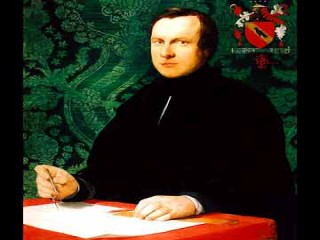
Augustus Welby Northmore Pugin biography
Date of birth : 1982-03-01
Date of death : 1852-09-14
Birthplace : London, UK
Nationality : British
Category : Arhitecture and Engineering
Last modified : 2011-01-04
Credited as : Architect, and designer, the Palace of Westminster
Augustus Welby Northmore Pugin was the most influential English ecclesiastical architect of his day and the principal theoretician of the Gothic revival.
Born in London on March 1, 1812, A. W. N. Pugin was the son of, and early assistant to, Augustus Charles Pugin, the producer of pattern books of Gothic building, such as Examples of Gothic Architecture (1831). The younger Pugin's conversion to Catholicism in 1834 led to a series of publications defending his chosen religion against the Established Church and advocating a correct Gothic style for its buildings. These publications had a great influence beyond the small circle of aristocratic Catholic restorationists, such as Lord Shrewsbury, who were Pugin's principal patrons.
Pugin's propaganda campaign began with the publication, at his own expense—since it was too controversial for a commercial publisher—of his intemperate Contrasts (1836; 2d ed. enlarged, 1841). The theme of contrast between the unity and goodness of the Middle Ages and the pluralism and degeneracy of the industrialized 19th century was common in intellectual circles of the time, but Pugin gave it architectural expression through a series of plates contrasting medieval with modern, classically inspired buildings. The final plate, in which buildings from the two periods are weighed on the scales of Truth and the modern ones "found wanting, " summed up Pugin's attitude. This work established architectural criticism on an ethical basis. Only good men (that is, Christians, and more specifically, Catholics) build good buildings (that is, Gothic ones; classical buildings are pagan). John Ruskin made this a fundamental principle of architectural criticism in his popular Seven Lamps of Architecture (1849).
Pugin's The True Principles of Pointed or Christian Architecture (1841) explained the Gothic as a rational, utilitarian architectural system in stone and announced the "two great rules for design" as "1st, that there should be no features about a building which are not necessary for convenience, construction, or propriety; 2nd, that all ornament should consist of enrichment of the essential construction of the building."
In Apology for the Revival of Christian Architecture in England (1843) Pugin added nationalism to religion as a justification for using Gothic forms. Christian or Gothic architecture is "the only correct expression of the faith, wants, and climate of our country … whilst we profess the creed of Christians, whilst we glory in being Englishmen, let us have an architecture, the arrangement and details of which alike remind us of our faith and our country." The classically inspired buildings of his contemporaries had no place in England because they were not Gothic and therefore neither Christian nor English.
The Present State of Ecclesiastical Architecture in England (1843), illustrating and describing Pugin's own church designs, pointed out his religious use of Gothic. His ornamental contributions in the English Perpendicular style to Charles Barry's Houses of Parliament (1836 onward) demonstrated the application of Gothic in the cause of nationalism.
Pugin's influence through these publications was farreaching, but his buildings, some 70 in all, also represent an impressive achievement. They range from small parish churches such as St. Giles's, Cheadle, Staffordshire (1841-1846), to cathedrals such as St. Chad's, Birmingham (1839-1841), and from great country houses such as Alton Towers, Staffordshire (1840-1844), the seat of Lord Shrewsbury, and Scarisbrick Hall, Lancashire (after 1837), to monastic and other institutional buildings such as St. John's Hospital, Alton, Staffordshire (1840-1842). Quality varies with the budget in these works, but all are more Victorian than Gothic, and they reflect the infant state of medieval studies of the period.
Pugin died on Sept. 14, 1852, in Ramsgate, Kent, and was buried there in the church of St. Augustine, designed and built (1846-1851) at his own expense.
The older biographies of Pugin by Benjamin Ferry, Recollections of A. N. Welby Pugin (1861), and by Michael Trappes-Lomax, Pugin (1933), have been superseded by Phoebe Stanton's well-illustrated Pugin (1970). For a brief account of Pugin's role in English Catholicism see Denis R. Gwynn, Lord Shrewsbury, Pugin and the Catholic Revival (1946). His buildings are discussed in the context of the architecture of his time in Henry-Russell Hitchcock, Early Victorian Architecture in Britain (1954). There are good chapters on Pugin's life and work in Kenneth Clark, The Gothic Revival (1928), and in Alexandra Clark, Victorian Architecture, edited by Peter Ferriday (1963).
Ferrey, Benjamin, Recollections of A. W. N. Pugin and his father Augustus Pugin, London: Scolar Press, 1978.
















